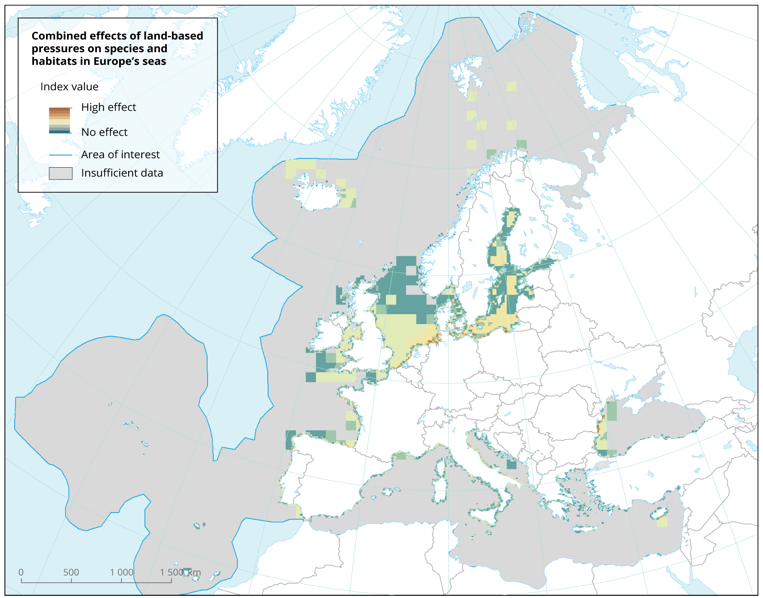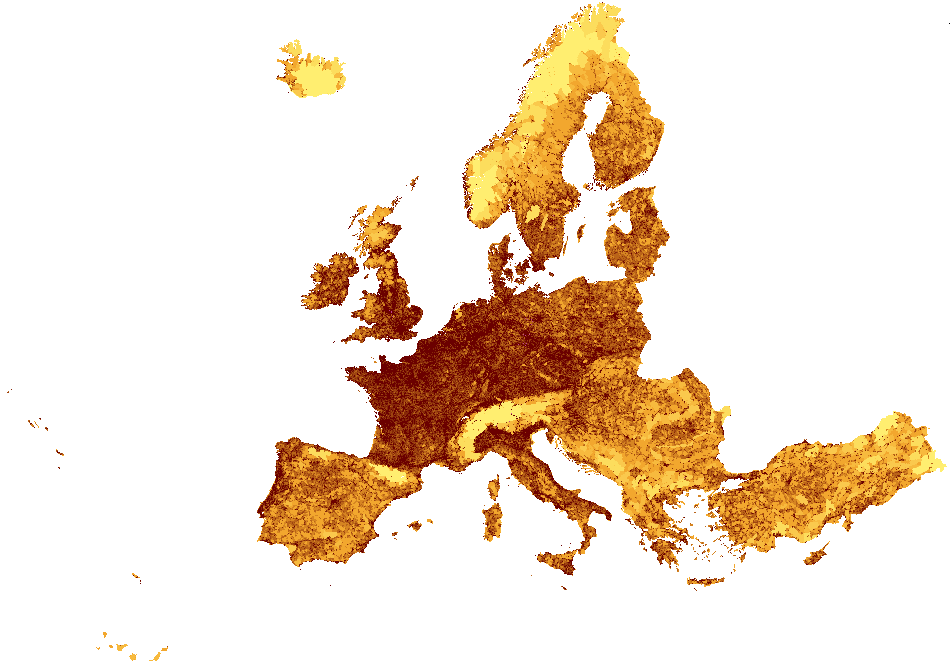irregular
Type of resources
Available actions
Topics
INSPIRE themes
Keywords
Contact for the resource
Provided by
Years
Formats
Representation types
Update frequencies
status
Scale
Resolution
-

The Effective Mesh Density (seff) is a measure of the degree to which movement between different parts of the landscape is interrupted by a Fragmentation Geometry (FG). FGs are defined as the presence of impervious surfaces and traffic infrastructure, focusing only on major roads. The more FGs fragment the landscape, the higher the effective mesh density hence the higher the fragmentation. The geographic coverage of the dataset is EEA39. An important consequence of landscape fragmentation is the increased isolation of ecosystem patches that breaks the structural connections and decreases resilience and ability of habitats to provide various ecosystem services. Fragmentation also influences human communities, agriculture, recreation and overall quality of life. Monitoring how fragmentation decreases landscape quality and changes the visual perception of landscapes provides information for policy measures that aim at improving ecosystem condition and restoration as well as maintaining the attractiveness of landscapes for recreational activities.
-

River Basin Districts (RBDs) and/or their subunits are the main units for the management of river basins and have been delineated by Member States under Article 3 of the Water Framework Directive. The geographic area of some RBDs span more than one country (such as the Danube) and these are known as International RBDs. Others are contained completely within a country and are known as National RBDs. River basin districts are defined as the area of land and sea, made up of one or more neighbouring river basins together with their associated groundwaters and coastal waters, which is identified under Article 3(1) as the main unit for management of river basins. Coastal waters are defined as one nautical mile from the coastline and extending, where appropriate, up to the outer limit of transitional waters. Coastal waters are included in RBDs, but this is not consistenly reported by Member States. Transitional waters are defined as bodies of surface water in the vicinity of river mouths which are partly saline in character as a result of their proximity to coastal waters but which are substantially influenced by freshwater flows. For more information about European waters, please visit the WISE portal (http://water.europa.eu/).
-

The dataset presents the potential combined effects of sea-based pressures on marine species and habitats estimated using the method for assessment of cumulative effects, for the entire suite of pressures and a selected set of marine species groups and habitats by an index (Halpern et al. 2008). The spatial assessment of combined effects of multiple pressures informs of the risks of human activities on the marine ecosystem health. The methodology builds on the spatial layers of pressures and ecosystem components and on an estimate of ecosystem sensitivity through an expert questionnaire. The raster dataset consists of a division of the Europe's seas in 10km and 100 km grid cells, which values represents the combined effects index values for pressures caused by sea-based human activities. The relative values indicate areas where the pressures potentially affect the marine ecosystem. This dataset underpins the findings and cartographic representations published in the report "Marine Messages" (EEA, 2020).
-

The dataset presents the potential combined effects of land-based pressures on marine species and habitats estimated using the method for assessment of cumulative effects, for the entire suite of pressures and a selected set of marine species groups and habitats by an index (Halpern et al. 2008). The spatial assessment of combined effects of multiple pressures informs of the risks of human activities on the marine ecosystem health. The methodology builds on the spatial layers of pressures and ecosystem components and on an estimate of ecosystem sensitivity through an expert questionnaire. The raster dataset consists of a division of the Europe's seas in 10km and 100 km grid cells, which values represents the combined effects index values for pressures caused by land-based human activities. The relative values indicate areas where the pressures potentially affect the marine ecosystem. This dataset underpins the findings and cartographic representations published in the report "Marine Messages" (EEA, 2020).
-

This personal geodatabase (compatible Access 1997 and beyond, ArcGis® 9.3.0 and beyond) contains the “lakes” datasets of Ecrins v1.0 Lakes are very important features of any hydrographical system and have hence been added to Ecrins. This feature is more uncertain than the other ones since it results from the processing of different sources under a twin constraint of relevance and free of charges accessibility. The current layer comprises 70,847 lake objects, that will certainly be updated in the months to come. A lake is, as a river both a geometric and cultural object. In areas where many lakes are intertwined, the difference between one and several lakes is often that a name has been found or not or that the Corine Land cover maker has placed a limit or not. The database comprises the following tables: feature class C_Lak with all information related to all still waterbodies which area is more than the Corine Land cover threshold, plus those identified because a reservoir or any other relevant source. This table is completed by the centroids of lakes, V_lak_Centro. The complex relationships between lakes and river segments are documented by table lakInOut where the inlet and the outlet(s) segments are reported. Complementary tables, needed by the water accounts, v_lakperadmin et v_linterfec respectively document the lake to administrative entities, with shared area and same with FECs. Being in relation with the other components of Ecrins, lakes are versioned with respect to catchments and rivers and with their update as well. Lake naming comes from fours sources: ERM, Eldred2, Art 13 reporting and Wikipedia. Hydrographical information (volume, Zaverage, Zmax) and is permanently updated from three source: Eldred2, the dams database, and Wikipedia In version 1.0, the history of lakes is not documented. Most natural lakes have a time span much before and beyond the expected duration of Ecrins. Artificial lakes, related to dams have their history documented with the dam and some natural lakes are intermittent. This last category is not documented. Since lower limit for lake inclusion is 25 ha, all “main lakes” under the WFD acceptation are present (except if missed for any reason, the most likely being creation of an artificial reservoir not present in the latest update). Full documentation is in EEA technical report 9/2012, downloadable from the EEA website.
-

The Effective Mesh Density (seff) is a measure of the degree to which movement between different parts of the landscape is interrupted by a Fragmentation Geometry (FG). FGs are defined as the presence of impervious surfaces and traffic infrastructure, including medium sized roads. The more FGs fragment the landscape, the higher the effective mesh density hence the higher the fragmentation. The geographic coverage of the dataset is EEA39. An important consequence of landscape fragmentation is the increased isolation of ecosystem patches that breaks the structural connections and decreases resilience and ability of habitats to provide various ecosystem services. Fragmentation also influences human communities, agriculture, recreation and overall quality of life. Monitoring how fragmentation decreases landscape quality and changes the visual perception of landscapes provides information for policy measures that aim at improving ecosystem condition and restoration as well as maintaining the attractiveness of landscapes for recreational activities.
-

EuroBoundaryMap (formerly known as SABE - Seamless Administrative Boundaries of Europe) provides a European geographic database for administrative and statistical regions that will be maintained at the source level by the National Mapping Agencies (NMAs), and by providing harmonized access conditions for this geographic information within the framework of EuroGeographics. EBM (1:100.000) offers the combined strength of detailed European administrative units and the linkage to its corresponding NUTS codes. a) Administrative units (Area controlled by an administrative unit [EBM_A]) b) Label points (Reference point for the main area of an administrative unit, can be used for labelling purposes [EBM_P]) c) Administrative boundaries (A line of demarcation between administrative controlled areas [EBM_L]) d) Derived units on higher national levels (Administrative units on higher hierarchical levels (USE-Regions [USE_X]), Derived national NUTS regions [NUTS_X]) More details are available in EuroBoundaryMap_v30_Specification.pdf
-

EuroBoundaryMap (formerly known as SABE - Seamless Administrative Boundaries of Europe) provides a European geographic database for administrative and statistical regions that will be maintained at the source level by the National Mapping and Cadastral Agencies (NMCAs). EuroGeographics is providing harmonized access conditions for this reference data. EBM v6.0 (1:100.000) offers the combined strength of detailed European administrative units and the linkage to corresponding NUTS codes. Feature catalogue: a) Administrative units (Area controlled by an administrative authority [EBM_A]) b) Label points (Reference point for the main area of an administrative unit, can be used for labelling purposes [EBM_P]) c) Administrative boundaries (A line of demarcation between administrative controlled areas [EBM_L]) d) Derived units on higher national levels (Administrative units on higher hierarchical levels (USE-Regions [USE_X]), Derived national NUTS regions [NUTS_X]) More details are available in EBM_v60_Specification.pdf
-

The raster file is the basis of the indicator for assessing landscape fragmentation due to urban and transport expansion, considering major roads only. The computation is based on the method of Effective Mesh Size (meff, Jaeger 2000). The effective mesh size (meff) can be interpreted as the area that is accessible to animals when starting a movement at a randomly chosen point inside a landscape without encountering a physical barrier. The meff expresses the probability that any two points chosen randomly in an area are connected, that is, not separated by the barriers of a Fragmentation Geometry (FG) such as transport routes or built-up areas. Hence, meff is a measure of landscape connectivity, i.e. the degree to which movements between different parts of the landscape are possible. The meff is measured as an area (km2), within the cells of a 1 km2 regular grid as reporting units.
-

EuroBoundaryMap (formerly known as SABE - Seamless Administrative Boundaries of Europe) provides a European geographic database for administrative and statistical regions that will be maintained at the source level by the National Mapping Agencies (NMAs), and by providing harmonized access conditions for this geographic information within the framework of EuroGeographics. EBM (1:100.000) offers the combined strength of detailed European administrative units and the linkage to its corresponding NUTS codes. a) Administrative units (Area controlled by an administrative unit [XX_A where XX is a country code]) b) Label points (Reference point for the main area of an administrative unit, can be used for labelling purposes [XX_P where XX is a country code]) c) Administrative boundaries (A line of demarcation between administrative controlled areas [XX_L where XX is a country code]) d) Derived units on higher national levels (Administrative units on higher hierarchical levels (USE-Regions [USE_X]), Derived national NUTS regions [NUTS_X]) More details are available in EuroBoundaryMap_v30_Specification.pdf
 RUC Geo-Data catalogue
RUC Geo-Data catalogue